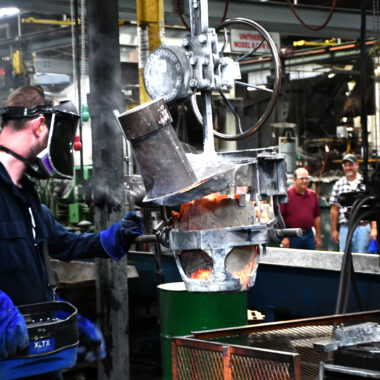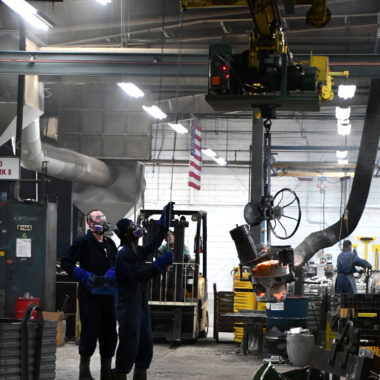Crafting Perfection: Just How to Achieve High-Quality Aluminum Castings Each Time
In the realm of aluminum spreading, the quest of perfection is a continuous journey that calls for a meticulous strategy and an eager understanding of the ins and outs included. Achieving consistent premium aluminum spreadings requires a detailed grasp of the processes, from picking the ideal alloy to carrying out exact mold and mildew styles and meticulously regulating spreading parameters. However, truth mastery depends on the capability to implement these components perfectly to develop perfect castings every single time. As we check out the intricacies of crafting perfection in light weight aluminum spreadings, uncovering the vital approaches and strategies that cause remarkable outcomes becomes vital for those aiming for excellence in this customized field.
Understanding Aluminum Casting Processes
Aluminum casting processes, vital in the production sector, entail the detailed makeover of liquified light weight aluminum right into strong kinds via a collection of carefully controlled actions. Understanding these processes is critical to achieving premium aluminum castings consistently - about aluminum casting. The primary methods used in light weight aluminum casting are pass away spreading, sand spreading, and investment casting

Each of these processes has its benefits and is selected based upon variables like intricacy, quantity, and wanted surface of the aluminum spreading. about aluminum casting. Understanding the complexities of these techniques is vital for manufacturers aiming to produce top quality aluminum spreadings continually
Choosing the Right Light Weight Aluminum Alloy
Choosing the appropriate light weight aluminum alloy is an essential choice in the production of high-quality light weight aluminum castings. The choice of alloy dramatically affects the buildings and attributes of the end product. Different light weight aluminum alloys use varying degrees of strength, deterioration resistance, machinability, and thermal conductivity. When choosing a light weight aluminum alloy for spreading, it is important to consider the certain requirements of the application to make certain optimal efficiency.
Among the most generally utilized light weight aluminum alloys for casting is A356. This alloy uses excellent castability, high stamina, and good rust resistance, making it ideal for a variety of applications. 6061 light weight aluminum alloy is preferred for its premium weldability and excellent mechanical buildings. For applications needing high strength, 7075 light weight aluminum alloy is a popular option as a result of its remarkable strength-to-weight proportion.
In addition to mechanical buildings, considerations such as see it here cost, availability, and post-casting procedures should likewise influence the choice of the best aluminum alloy. By very carefully reviewing these variables, suppliers can make certain the manufacturing of high-quality aluminum spreadings that fulfill the wanted requirements.
Applying Proper Mold And Mildew Layout
Establishing an efficient mold design is essential for ensuring the effective manufacturing of premium light weight aluminum castings. Proper mold and mildew style plays a substantial duty in attaining the preferred characteristics of the last item. To apply an effective mold layout, aspects such as material flow, cooling down rates, and part geometry need to be very carefully thought about.
One secret aspect of mold and mildew design is making certain appropriate filling and solidification of the aluminum within the mold cavity. This includes developing runner and gating systems that promote smooth metal circulation and avoid defects such as air entrapment or incomplete dental filling. In addition, incorporating air conditioning channels right into the mold style aids manage solidification rates and lower the risk of porosity or contraction defects.

Controlling Casting Parameters

Guaranteeing Post-Casting Quality Checks
To keep the excellent quality of light weight aluminum castings, comprehensive post-casting top quality checks are vital. After the casting process is finished, it is important to ensure that look at this website the last items fulfill the preferred requirements and requirements. Among the primary high quality checks entails checking the surface area finish of the spreadings to identify any type of issues such as porosity, fractures, or surface area irregularities. This aesthetic evaluation is usually supplemented by non-destructive testing approaches like ultrasonic screening or dye penetrant examination to discover inner defects that might compromise the stability of the spreading.
Dimensional precision is an additional essential facet that needs to be validated throughout post-casting top quality checks. Measurements of vital measurements and resistances need to be required to confirm that the castings comply with the required specifications. Furthermore, mechanical properties such as hardness, tensile strength, and impact resistance may require to be evaluated via product screening to make certain that the castings have the essential toughness and durability for their intended application.
Conclusion
To conclude, achieving premium light weight aluminum castings requires a complete understanding of the casting procedures, choosing the suitable alloy, designing mold and mildews properly, regulating casting parameters diligently, and carrying out post-casting high quality checks vigilantly. By following these actions, makers can regularly produce light weight aluminum castings that meet the highest possible requirements of quality and efficiency.
Accomplishing consistent high-quality light weight aluminum castings requires an extensive grasp of the procedures, from selecting the ideal alloy to carrying out accurate mold and mildew styles and meticulously regulating casting criteria. The main approaches utilized in aluminum spreading are die spreading, sand spreading, and investment spreading.
Financial investment casting, additionally understood as precision spreading, includes developing wax patterns that are coated in ceramic to create molds.Choosing the appropriate aluminum alloy is a critical choice in the manufacturing of premium light weight aluminum castings.Making sure precise control over casting criteria is important for keeping consistency and high quality in light weight aluminum spreading production.